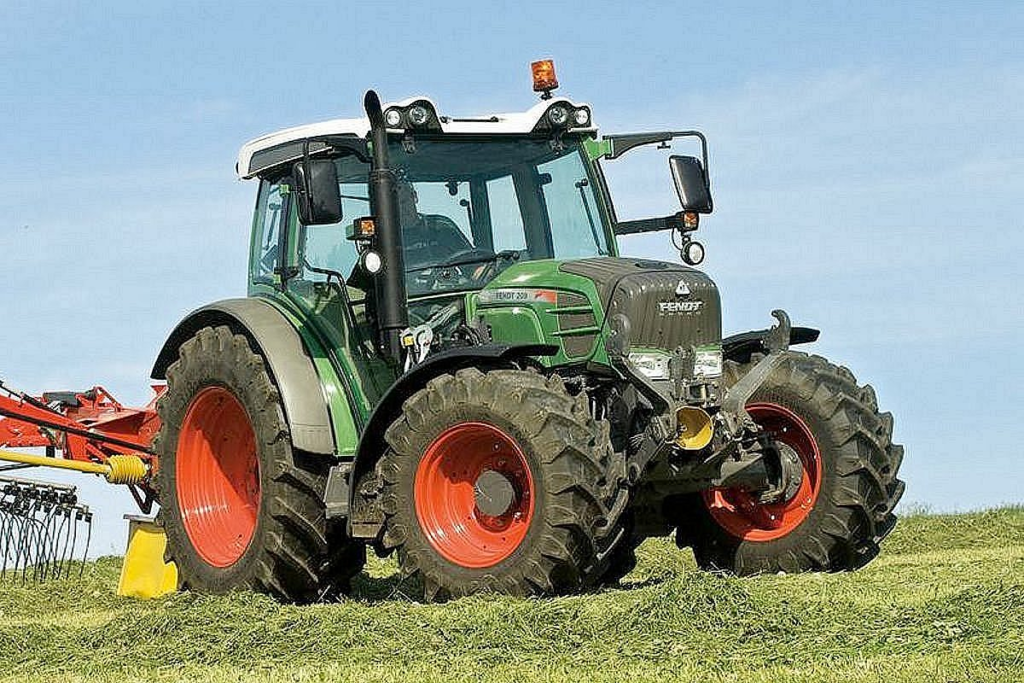Tractor Operator( 6 month course)
Tractor Operator

Tractor and Operator: A person who is in charge of tractor operation for agricultural purposes and also handles the same periodic maintenance. Brief description of the job: The person keeps the car free of complaints, repairs the basics wherever it works and where necessary and performs various agricultural activities according to the needs of the farmers. Personal Qualifications: The operator must be efficient, sensitive to the needs of the farmer and must have the ability to repair and maintain (minor) tractors where necessary. You need to have a basic understanding and skills in crop management. One has to deal with the consequences and manage one’s performance and learning Tractor Operator.

Operation of the Tractor Tractor Operator:
In order to function properly, a person at work must be able to: PC1. lubricate the backbone carrier (daily / as recommended by the manufacturer) PC2. check engine oil PC3. check PC4 oil delivery rate. check the oil of the PC5 control box. check PC6 cooling rate. remove water and sewage from the PC7 fuel filter. lubricate the tire tie end PC8. lubricate PC9 spinning stems. lubricate the front axle pivot pin PC10. lubricate clutch connections, hand connector clamps, foot connections and all PC11 components. Pure PC12 pre-cleaning. check for leaks if there is PC13. check the performance of all PC14 lamps. check the strength of the nuts nuts PC15. use nipple inserting (once every 50 hours on dry ground and once every 10 hours to recommend wet soil) Significance of Ballasting and procedure In order to be effective, a person on the job should be able to: PC16. use of ballasting according to PC & DC requirements or Hydraulic lift operation To be competent, a person on the job must be able to: PC17. use pc & dc levers as per the requirement and with integrated PC18 control / mixing. performance of hydraulic lift with low weight low links – check Tractor Operator:
Draft Position control Response control Gear selection and RPM To be competent, a person on the job should be able to: PC19. make the right gear and selection of RPM Implements And Trailer To be competent, the person on the job should be able to: PC20. divide farm implements into primary farming equipment, second plowing tools, measuring machines and PC21 trailers. separate cat i no ii using PC22. select the appropriate setting for a specific PC23 task. take precautionary measures before using equipment and trailer Land Land Preparation Need & Land Opening To be competent, a person on the job should be able to: PC24. select and suggest resources according to the farmer’s PC25 requirement. measure drill seeds according to each requirement PC26. do the following work: Land preparation: Basic and second plowing Attached field measurement Availability of farm produce area In order for a Tractor to be efficient, the person on the job must be able to: PC27. perform vertical and horizontal adjustment of PC28 equipment. to perform the input and output of the inserted from the operation of the tractor To be competent, the person on the job must be able to: PC29. gauge functions and controls for PC30. wheeled track set- operating system and demo PC31. binding and connecting operating systems PC32. types of tools and their use, field performance methods and field performance improvements PC33. to prepare the tractor for field operation PC34. fix hold & break Tractor Operator
Organizational Context (Knowledge of the company / organization and its processes) Tractor Operator:
The user / person at work needs to know and understand: KA1. applicable law, standards, policies, and procedures in the workplace KA2. appropriate health and safety requirements applicable to workplace KA3. your role and responsibilities and job information resources KA4. who can request assistance for information related to the operation, clarification and support of KA5. the importance of compliance with health, hygiene, safety and quality standards and the impact of non-compliance on consumer and business KA6. documents and related procedures applicable to the context of the work Tractor Operator
Technical Knowledge:
The person at work needs to know and understand: KB1. Various climatic factors such as high and low temperatures, pressure and distribution (rainfall), relative humidity, etc., affect field performance KB2. Landscape, topography, soil type, soil moisture level, type of previous crop and crop to be sown, sowing method, planting depth KB3. Selection of suitable tools, implements and equipment for different field operations according to tractor hp, pto speed, topography, soil, yield and KB4 sowing method. Metallurgy and metallurgy, a variety of agricultural methods, types of applications and uses, field operations, tractor repair and installation, machinery and equipment for field work KB5. Planting method and depth, seed bed adjustment according to plants & planting depth and spraying height and yield yield KB6. All attachments are also KB7. Significance of the depth and width of the KB8 cut. Importance of Mast Height KB9. Farming methods (distribution and collection) KB10. Proper method of operation to ensure the efficient use of fuel KB11. Selection of appropriate gears, pto speed, rpm engine KB12. All functions listed on the dashboard such as PTO Engaged Indicator Fuel Gauge Air Conditioning Index Higher Beam Indicator Hour Meter Charging System Indicator
Cum hour RPM meter Turn Up Signal Direction Indicator PTO speed indicator (540/1100 rpm) 4-wheel drive indicator Accident indicator KB13. Hand pinch KB14. Driving Wheel KB15. Horn KB16. Light Change KB17. Change key KB18. Risk Change KB19. Change Signal Change KB20. Bemba Pedal KB21. Fuel disconnection of KB22. Foot pin KB23. Brake step KB24. Effective hand binding KB25. Selecting Controller Lever KB26. Rockshaft Position Control Lever KB27. Rockshaft Draft Control Lever KB28. Gear Shaft oar KB29. Search hold the oar KB30. Shaft lever range KB31. Rockshaft level drop valve KB32. Separation Lock Pedal KB33. Isolator valve KB34. Back to PTO lever KB35. Search the oars KB36. Reverse shuttle KB37. Switches lamp switch KB38. The driver’s seat changes KB39. 7-pole socket KB40. To drive you must also have a license to drive a tractor issued by an authorized body. KB41. Road traffic awareness / road safety rules KB42. Manufacturer recommendations for use of KB43. Safe methods of handling tools KB44. First aid KB45. Stickers and security logos Tractor Operator.

Core Skills/ Generic Skills:
The person at work needs to know and understand how to do this: SA1. write down various readings — fuel consumption, Kilometers run etc. Learning Skills An employee needs to know and understand how to do this: SA2. read the Oral Communication Workbook (listening and speaking skills) The person at work needs to know and understand how to do this: SA3. Maintain active SA4 relationships. Contact others such as farmers, official / affected stakeholders SA5. Collaborate with others on the required SA6 procedures. understand the details and understand its meaning SA7. Seek advice from adults B. Making Professional Skills Decisions A person at work needs to know and understand how to do it: SB1. Make decisions for the affected area of SB2 activity. Identify potential problems in performing tasks and take preventive action Plan and Edit The person at work needs to know and understand: SB3. plan the various field operations Customer Centricity The person on the job needs to know and understand how to do: SB4. manage relationships with co-workers and other farmers Problem Solving A person at work needs to know and understand how to do this: SB5. Think about the problem, try out the possible solutions (s) and come up with the biggest solution (s) (s) SB6. Deal with other employees who do not have the technical knowledge to solve the problem with their SB7. Find quick fixes for design delays Tractor Operator
Tractor Maintenance:
In order to function properly, a person at work must be able to: PC1. follow regular PC2 maintenance intervals. lubricate the different parts of the PC3 tractor. follow the basic operating instructions Getting Certified PC4 Tools. purchase certified maintenance tools for such activities from an authorized body. Check And Save Water / PC5 Cooling Points. check engine oil PC6. check PC7 fluid / compressor. check radiator coolant / dam tank PC8. bleeding of the PC9 fuel system. clean clean oil / dry air cleaner PC10. test engine, transmission, fluid, steering oil and overhead if necessary PC11. change the fuel filters and electrical fuses PC12. check the electrolyte battery level Verify the Right Tires Pressure PC13. ensure that all wheels have the right price pressure such as the use of a PC14 tractor. remove and repair piercing tires Check Belts And Hoses PC15. if the installation or connection is leaking, tighten or insert some of the signals. Brake And Capture Modify PC16. ensure proper braking and clutch adjustment, and make sure brakes and clutches free play are adjusted for PC17. make sure that the brake screen is applied while driving Tractor Operator.

Organizational Context (Knowledge of the company / organization and its processes) Tractor Operator:
The user / person at work needs to know and understand: KA1. applicable law, standards, policies, and procedures in the workplace KA2. appropriate health and safety requirements applicable to workplace KA3. your role and responsibilities and job information resources KA4. who can request assistance for information related to the operation, clarification and support of KA5. the importance of compliance with health, hygiene, safety and quality standards and the impact of non-compliance on consumer and business KA6. documents and related procedures applicable to the context of the work
Technical Knowledge:
The person at work needs to know and understand: KB1. Various climatic factors such as extremely low temperatures, pressure and distribution (rainfall), relative humidity etc., KB2. Know what equipment can be attached and what KB3 is. Secure ways to manage KB4 tools. First aid KB5. Understand stickers and security logos KB6. HIV awareness
Core Skills/ Generic Skills:
The person at work needs to know and understand how to do this: SA1. write down various readings — fuel consumption, Kilometers run etc. Learning Skills An employee needs to know and understand how to do this: SA2. read the Oral Communication Workbook (listening and speaking skills) A person at work needs to know and understand how to do this: SA3. Maintain active SA4 relationships. Contact others such as farmers, official / affected stakeholders SA5. Collaborate with others under the required procedures SA6. understand the details and understand its meaning SA7. Seek advice from adults B. Making Professional Skills Decisions A person at work needs to know and understand how to do it: SB1. Make decisions for the affected area of SB2 activity. Identify potential problems in performing tasks and take preventive action Plan and Edit The person at work needs to know and understand: SB3. plan the various field operations Customer Centricity The person on the job needs to know and understand how to do: SB4. manage relationships with co-workers and other farmers Problem Solving A person at work needs to know and understand how to do this: SB5. Think about the problem, try out the possible solutions (s) and come up with the biggest solution (s) (s) SB6. Deal with other employees who do not have the technical knowledge to solve the problem with their SB7. Find shocking and new solutions to delay delays Thinking Consideration A person at work needs to know and understand: SB8. Check and maintain the condition of the SB9 tractor. Apply, analyze, and evaluate information collected from observation, experience, consultation, or communication, as a guide to thinking and practicing Critical Thinking The person at work needs to know and understand: SB10. take personal reading Tractor Operator

Maintain health & Safety at the work place:
In order to be effective, that person must be able to: PC1. inspect basic safety prior to the operation of all equipment and vehicles and accidents reported to the appropriate PC2 manager. work in which protective clothing or equipment is identified and appropriate clothing or equipment used in carrying out these activities in accordance with the workplace policy. PC3. read and understand the dangers of use and pollution mentioned on the labels of pesticides / explosives etc. PC4. check the risk before performing manual operations, and act in accordance with the recommended safe practice currently in place. PC5. use equipment and building materials and restore the same to designated storage where PC6 can be used. dump garbage at PC7 selected location. detect hazards in viewers and take steps to reduce the risks associated with activities in the PC8 workplace. do your job in a way that minimizes environmental damage all procedures and work instructions for risk management are followed. PC9. report any accidents, incidents or problems without delay to the appropriate person and take the necessary immediate steps to reduce the risk. Providing appropriate emergency procedures In order to be effective, that person must be able to: PC11. Follow emergency procedures to meet the company’s standard / workplace requirements PC12.Using emergency equipment with manufacturer details and work requirements PC13.provide appropriate treatment for patient injuries according to PC14 first aid techniques. Detect (if possible), clean, test / test, reset, restore and save file Tractor Operator

Organizational Context (Knowledge of the company / organization and its processes) Tractor Operator:
The user / person at work needs to know and understand: KA1. applicable law, standards, policies, and procedures in the workplace KA2. appropriate health and safety requirements applicable to workplace KA3. your job role and responsibilities and resources about KA4 work. who can request assistance for information related to the operation, clarification and support of KA5. the importance of compliance with health, hygiene, safety and quality standards and the impact of non-compliance on consumer and business KA6. documents and related procedures applicable to the context of the work
B. Technical Knowledge Tractor Operator:
The user / person at work needs to know and understand: KB1. hygiene and fitness requirements KB2. your normal activities under the relevant health and safety law KB3. what protective equipment and clothing should be worn and how KB4 is cared for. efficient and safe use of materials and equipment required for your work KB5. the importance of proper housing maintenance in the workplace KB6. ways to secure waste disposal KB7. ways to reduce environmental damage during operation KB8. health and safety hazards and steps to be taken to manage those risks in your workplace KB9. Workplace procedures and requirements for occupational injury / illness. KB10. basic emergency first aid program KB11. local paramedics KB12. why accidents, incidents and problems should be reported and steps to be taken Tractor Operator
Core Skills/ Generic Skills:
The user / person at work needs to know and understand how to do this: SA1. state the details required for SA2 objectives. report problems to relevant staff during SA3. write descriptions and details of events in reports Learning Skills The user / employee needs to know and understand how to do this: SA4. read a handbook and Oral Communication Toolkit (Listening and Speaking Skills) The user / person at work needs to know and understand how to do this: SA5. liaising with other stakeholders such as farmers, official / affected stakeholders SA6. understands information shared by senior people and experts B. Practicing Professional Skills A user / employee needs to know and understand how to do this: SB1. make decisions about the types of tools SB2 will use. identify the need for first aid and provide it Plan and Edit The user / person at work needs to know and understand that: SB3. plan daily activities and set priorities; separate start times, estimate completion times and building materials, equipment and assistance needed for completion. Customer Location The user / person at work needs to know and understand how to do this: SB4. manage relationships with co-workers and managers of those who may be stressed, frustrated, confused or angry Solving Problems A user / employee needs to know and understand: SB5. quick identification of problems and immediate solutions to resolve delays Analytical Thinking The user / employee needs to know and understand: SB6. view and maintain SB7 tools and equipment. assess the situation and identify appropriate control measures Key Thinking The person at work needs to know and understand: SB8. take personal reading

Guidelines for Assessment:
- Criteria for assessment for each Qualification Pack will be created by the Sector Skill Council. Each Performance Criteria (PC) will be
assigned marks proportional to its importance in NOS. SSC will also lay down proportion of marks for Theory and Skills Practical for
each PC. - The assessment for the theory part will be based on knowledge bank of questions created by the SSC.
- Assessment will be conducted for all compulsory NOS, and where applicable, on the selected elective/option NOS/set of NOS.
- Individual assessment agencies will create unique question papers for theory part for each candidate at each examination/training
center (as per assessment criteria below). - Individual assessment agencies will create unique evaluations for skill practical for every student at each examination/training
center based on this criterion. - To pass the Qualification Pack , every trainee should score a minimum of 70% of aggregate marks to successfully clear the
assessment. - In case of unsuccessful completion, the trainee may seek reassessment on the Qualification Pack.








